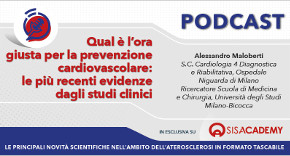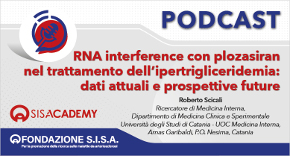 Rivista in lingua italiana
Rivista in lingua italiana
riservata ai Soci SISA
Ultimo numero:
Anno 16 • N.1/2025
SISANews
Fumo e lipoproteine
Che il fumo sia parte in causa nella morbilità cardiovascolare è cosa ben nota da tempo. Meno note sono le cause che sembrano essere molteplici. Tra queste, le alterazioni del quadro lipidico e, in particolare un aumento del colesterolo LDL ed una diminuzione di quello HDL. Gli effetti del fumo sulle lipoproteine potrebbero essere mediati dalla liberazione di catecolamine che determinerebbero un aumentata sintesi di VLDL e LDL cui conseguirebbe una diminuzione di HDL. A sua volta questa potrebbe essere dovuta direttamente ad una diminuzione della lecitina-colesterolo aciltransferasi e della proteina di trasferimento lipidico (CETP), fenomeni che sono stati osservati, seppure incostantemente, dopo il fumo di sigaretta. Se così fosse ci si dovrebbe attendere che la sospensione del fumo sia seguita da una diminuzione del colesterolo LDL e da un aumento di quello HDL. A parziale conferma delle ipotesi, Gepner e coll, hanno effettivamente osservato, dopo sospensione del fumo, effetti positivi sulle HDL (aumento del colesterolo HDL e delle dimensioni delle HDL), ma nessun effetto sulle LDL.
![]()
Effects of smoking and smoking cessation on lipids and lipoproteins: outcomes from a randomized clinical trial
Gepner AD, Piper ME, Johnson HM, Fiore MC, Baker TB, Stein JH.
Am Heart J 2011;161:145-51
BACKGROUND: the effects of smoking and smoking cessation on lipoproteins have not been studied in a large contemporary group of smokers. This study was designed to determine the effects of smoking cessation on lipoproteins.
METHODS: this was a 1-year, prospective, double-blind, randomized, placebo-controlled clinical trial of the effects of 5 smoking cessation pharmacotherapies. Fasting nuclear magnetic resonance spectroscopy lipoprotein profiles were obtained before and 1 year after the target smoking cessation date. The effects of smoking cessation and predictors of changes in lipoproteins after 1 year were identified by multivariable regression.
RESULTS: the 1,504 current smokers were (mean [SD]) 45.4 (11.3) years old and smoked 21.4 (8.9) cigarettes per day at baseline. Of the 923 adult smokers who returned at 1 year, 334 (36.2%) had quit smoking. Despite gaining more weight (4.6 kg [5.7] vs 0.7 kg [5.1], P < .001], abstainers had increases in high-density lipoprotein cholesterol (HDL-C) (2.4 [8.3] vs 0.1 [8.8] mg/dL, P < .001), total HDL (1.0 [4.6] vs -0.3 micromol/L [5.0], P < .001), and large HDL (0.6 [2.2] vs 0.1 [2.1] micromol/L, P = .003) particles compared with continuing smokers. Significant changes in low-density lipoprotein (LDL) cholesterol and particles were not observed. After adjustment, abstinence from smoking (P < .001) was independently associated with increases in HDL-C and total HDL particles. These effects were stronger in women.
CONCLUSIONS: despite weight gain, smoking cessation improved HDL-C, total HDL, and large HDL particles, especially in women. Smoking cessation did not affect LDL or LDL size. Increases in HDL may mediate part of the reduced cardiovascular disease risk observed after smoking cessation.

Area Soci
Eventi
39° Congresso Nazionale
 39° Congresso Nazionale
39° Congresso NazionaleRoma, 23-25 novembre 2025
Save the date




 Spring Meeting Gruppi Giovani SID, SIGG, SIIA, SIMI, SIPREC, SISA
Spring Meeting Gruppi Giovani SID, SIGG, SIIA, SIMI, SIPREC, SISARimini, 6-8 aprile 2025
[continua a leggere]
 SISA LIPID ACADEMY - Corso avanzato di lipidologia clinica
SISA LIPID ACADEMY - Corso avanzato di lipidologia clinicaModena, 4-5 Luglio 2024
[continua a leggere]Giornale Italiano Arteriosclerosi
HoFH today
 Rivista Italiana della
Rivista Italiana della
Ipercolesterolemia
Familiare Omozigote
Anno 6 • N.1/2024
Rivista NMCD
Diateca
[continua a leggere]
[continua a leggere]
Newsletter
il vostro indirizzo di posta elettronica
Progetto LIPIGEN

Nuovo sito dedicato al Progetto LIPIGEN
Progetto LIPIGEN - Vecchio portale
E' necessario essere loggati come utente
Lipigen per poter accedere alla pagina
PROject Statin Intolerance SISA
PROSISA – PROject Statin Intolerance SISA
E' necessario essere loggati come utente
PROSISA per poter accedere alla pagina
GILA - Lipoprotein Aferesi
Gruppo Interdisciplinare Lipoprotein Aferesi
(Accesso Gruppo GILA-Lipoprotein Aferesi)
E' necessario essere loggati come utente del Gruppo GILA per poter accedere
Gruppo Interdisciplinare Lipoprotein Aferesi
(Documentazione ad accesso libero)
Pagina informativa per medici e pazienti










